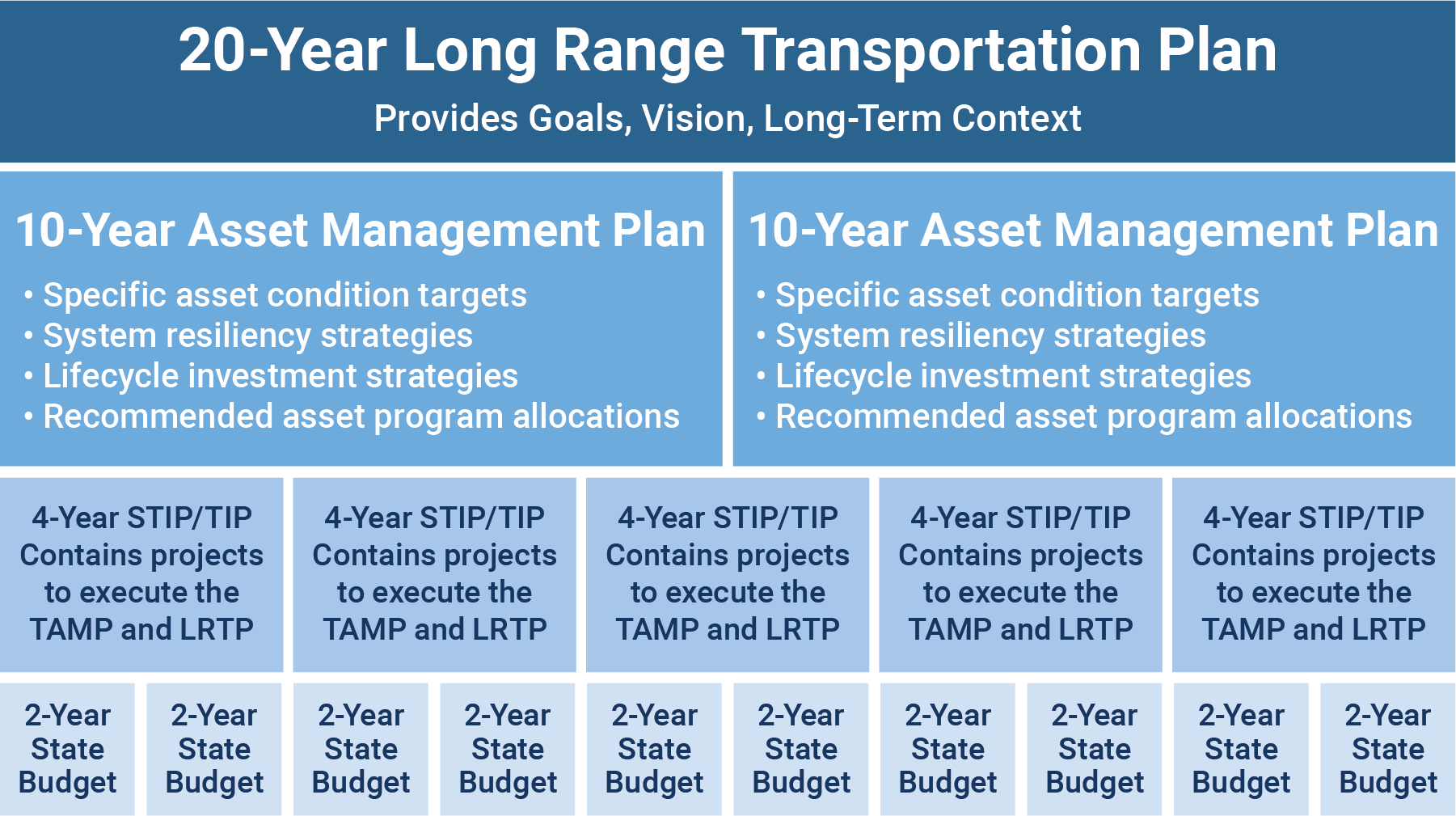- Chapters
-
Chapter 2
Sections - Chapter 2 Home Page
- Chapter PDF
Chapter 2
Quick Links
2.2.1
Planning and Programming
Linking and aligning asset management with planning and programming activities helps strengthen an agency's delivery of projects. Planning and programming processes set strategic direction and resource allocation practices; TAM helps set priorities and encourages data-driven, performance-based decision-making.
Using the TAMP Approach to Look at Demand Scenarios
Planning is the process of setting strategic direction through goals and objectives, then performing analysis to identify trends, strategies, and long-term investment priorities. Planning answers the questions of where to go and how to get there. Programming involves allocating resources in order to determine a program of projects the agency will pursue. Planning and programming are central to the work of any transportation agency. Integrating TAM into the planning and programming process will only strengthen and sustain the practices involved in both areas.
Developing the Long-Range Transportation Plan (LRTP) and the Statewide Transportation Improvement Plan (STIP) are two planning activities where the integration of TAM is especially relevant.
TAM principles, data and tools can help shape the LRTP and STIP by:
- Linking agency resource allocation to policy objectives.
- Defining the performance targets to be achieved.
- Identifying strategic investment choices and evaluating and analyzing tradeoffs among them at the appropriate stages.
- Providing the information and analyses to facilitate the appropriate resource allocation decisions that follow good TAM practice.
Integrating TAM approaches with planning and programming goes beyond informing and shaping the activities. Communication and coordination between activities and the people involved in them is important as well. Both planning and TAM require an understanding of the life cycle of an asset. This requires coordination with operations teams to communicate how decisions impact the expected useful life of the asset. Operations teams also need to be aware of the asset management planning horizon, performance measures and targets. These teams need to ensure the capital plan has been accounted for in the maintenance and operational plans. In addition, since planning is a network-level endeavor, teams managing each of the different asset types need to communicate with one another and coordinate with planning.
The following are some key questions to ask when considering the integration of TAM with planning and programming.
- Is the cost of maintenance and operations taken into account in the decision-making process to select capital projects?
- Are there mechanisms to directly evaluate tradeoffs between capital investment and operations and maintenance implications within the planning process?
- Are the needs and implications associated with connected and autonomous vehicles considered in the asset management plan?
- Are future risks such as climate change fully integrated into the capital planning process (rehabilitations, renewal, service level upgrades, etc.)? Is scenario planning used to assess the risk effects of system wide external changes?
TIP
TAM practice is most effective when linked to planning and programming activities; this is one way to ensure that TAM principles are implemented into agency decision making.
The FHWA Asset Management Financial Report Series, Report 4 Integrating Financial Plans into the Planning, Programming, and Budgeting Processes describes the importance of integrating planning, programming, and budgeting with asset management.
The relative timeframes of various planning and programming activities is shown in Figure 2.2.
Figure 2.2 The Relative Timeframes Between Plans
Long-range plans, asset management plans, TIPs, and state budgets should be aligned.
Source: FHWA, 2017. https://www.fhwa.dot.gov/asset/plans/financial/hif16001.pdf
TIP
Involving internal and external stakeholders in the TAM process early can encourage or enhance their buy-in when the time comes to make important decisions.
Montana DOT
When developing their 2018 TAMP MDT aligned their pavement performance targets and goals to those within their planning document TranPlan 21 (now TranPlanMT). TranPlanMT defines MDT's policy direction for operating, preserving, and improving Montana’s transportation system over a 20-year period. It serves as the guiding document for MDT decisions, especially those related to investing Montana’s limited transportation funds. This type of alignment can help illustrate a link from policy objectives to investment strategies and resource allocation.
Sources:
Video Overview of Planning TAM
Integrating TAM Into the Planning Process
The FHWA TAM Expert Task Group produced the following video to explain how to integrate TAM into the transportation planning process.

